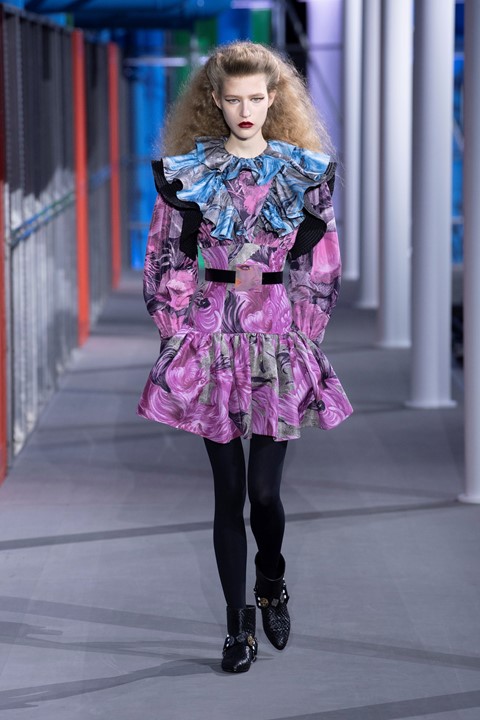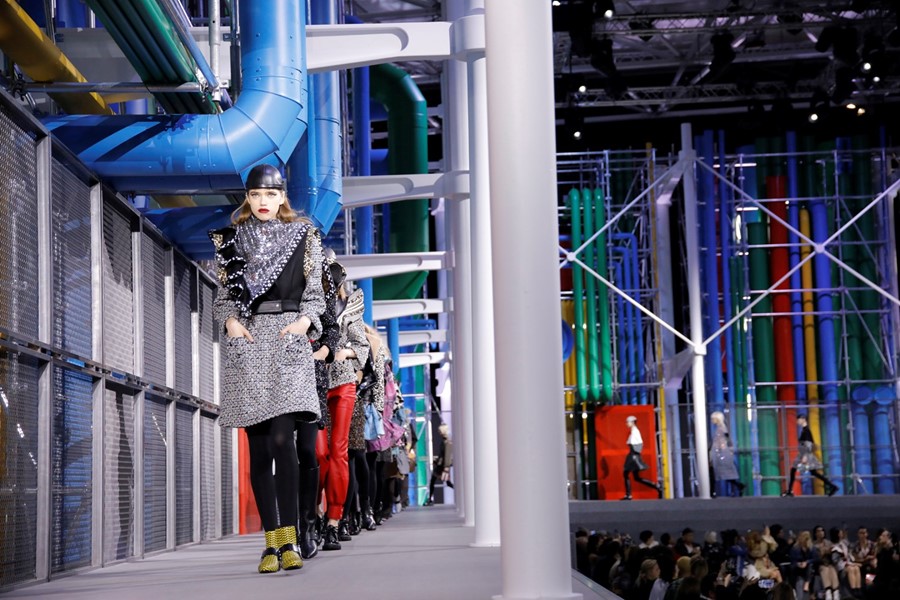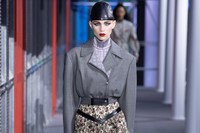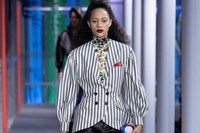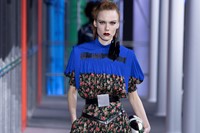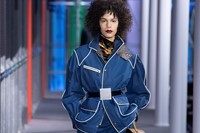As fashion weeks draws to an end, we look at the five tenets of Nicolas Ghesquière’s philosophy for Louis Vuitton
Closing fashion month on Tuesday, Nicolas Ghesquière presented a “sartorial melting pot” for Louis Vuitton – but it was a cultural one too. Reimagining the Centre Pompidou and its melange of cliques, styles and lives, the creative director transported the Playmobil piping and “social epicenter” courtyard of the Renzo Piano- and Richard Rogers-designed museum to another museum courtyard – that of the Louvre’s Cour Carrée. A celebration of the clash of old and new – between the bombastically modern Pompidou, built in 1977, and its historic neighbourhood; between that same museum and the Louvre; between ultra-80s prints and 18th-century ruffles – this meta mish-mash presented the hybridisation that drives Ghesquière’s Vuitton more broadly. Since his arrival at the French maison in 2013, the designer has riffed on the heritage codes established since its opening in 1854, intertwining them with an unequivocally futuristic, sci-fi bent. Here, we dissect the five key codes of Ghesquière’s Louis Vuitton.
The Petite Malle
Luggage is the foundation on which the Vuitton empire is built. In the early 19th century, the 16-year-old Monsieur Vuitton spent two years walking the 400-kilometre journey from his home in the foothills of the Jura mountains, to Paris, funded by odd manservant jobs including one as an emballeur (a packer) for Empress Eugénie, wife of Napoleon III. His first job in Paris once he’d arrived, was as a layetier (a trunk-maker) and in marrying these two skills, he designed the first flat-topped trunk in a water-resistant leather and quickly revolutionised the way the bourgeoisie travelled, amid a key-change moment in the history of tourism. The rest is written in the fashion house’s ubiquitous monogram, and its countless covetable iterations since. It was perhaps then inevitable that Ghesquière, after his news-breaking shift from Balenciaga, should nod to this conception story in his very first outing for the house.
Cast your mind back to A/W14, and you’ll find Freja Beha Erichsen in the opening look: a panelled cream A-line dress atop a white ribbed roll-neck, beneath a luscious black leather coat with a wide, satsuma-coloured lapel. In her hand, a Petite Malle: a shrunken trunk emblazoned with that same brown monogram, a black leather trim and fastened by the house’s patented Tumbler Lock. Across its corner were three italicised red strikes, which have since been seen stippled across clothing and handbags alike over subsequent seasons. Ghesquière lifted this emblem from the trunk of one of Vuitton’s favoured customers – the banker and traveller Albert Kahn, whose trunks wrapped in bespoke red, water-repellent and artight canvas, and built with rope handles (so they could be carried on bamboo poles while in Africa and Asia), bore his signature strikes in white. Emerging in croc, aluminium, copper, lightweight carbon, and shrunken into iPhone cases, and card holders – the Petite Malle appears again and again in ever-pleasing miniature versions.
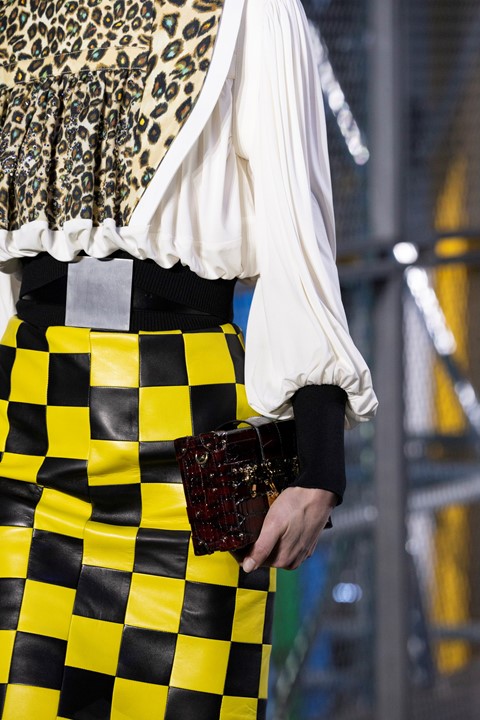
The savoir-faire of leatherwork
Leather took over from Monsieur Vuitton’s original water-repellent canvas as the house’s go-to cladding for its cases. Today, 170 craftsmen work in the Vuitton workshop at the property in Asnières-sur-Seine – the family’s former Art Nouveau-decorated home – and handcraft all manner of bespoke luggage, cases and vessels that facilitate the artful travel of the label’s clients. As such, Ghesquière nods to the house’s favourite fabric in all of his collections. From the macro – Motocross-inspired leathers, sumptuous biker jackets, panelled dresses, suede colour-blocking and patchwork leather – to the micro – delicate leather panels on silk slips, leather braiding on the shoulders of chiffon blouses, laced-up skirts, intricate fretworks of punched leather lace on a Medieval bodice – the fabric is omnipresent. In a meta refraction of these nods, the designer transposed his own leather design – the plush quilted Malletage leather inspired by the criss-cross lining of classic Vuitton trunks, seen on the Go-14, the Twist, and the Alma bags over his tenure – airbrushed onto fabric, creating a trompe l’oeil padded effect.
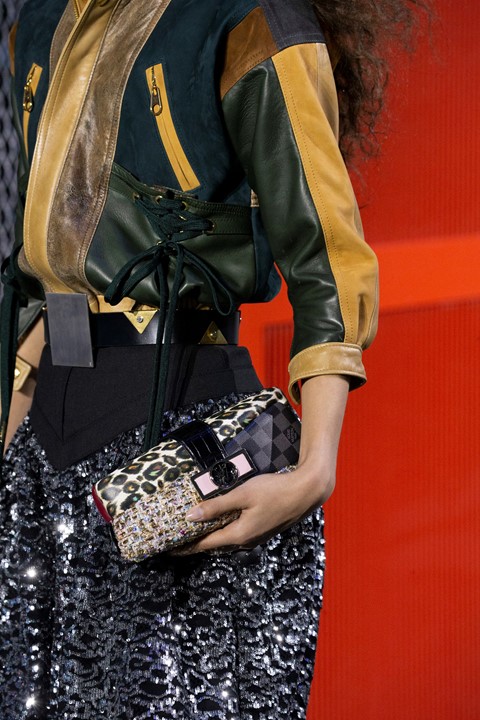
The A-line silhouette
This shape is exclusive to Ghesquière’s Vuitton, announced in that very first panelled cream shift dress presented for the brand. The A-line silhouette has since seen countless iterations: in that same collection as a Jetsons-esque zip-up dress, complete with formica tablecloth print and orange skirt, as a button-up skirt in Woodstock brown suede, cinched with a matching belt (Resort 2015), a dissected kilt (S/S16), a belted patchwork suede coat with striped undershirt that fans out in imitation of an A-line skirt (Resort 2018). And the silhouette isn’t exclusive to dresses and skirts: Lous XIV frock coats splay out into A-line waists, leather pelmuts flick out over the waistbands of trousers, waistcoats hike outwards – each time putting the waist centre-stage in a manner at once clean, modern and Amazonian. Each nod to the past is offset by an underlying note of warrior-wear, armed for intergalactic warfare.
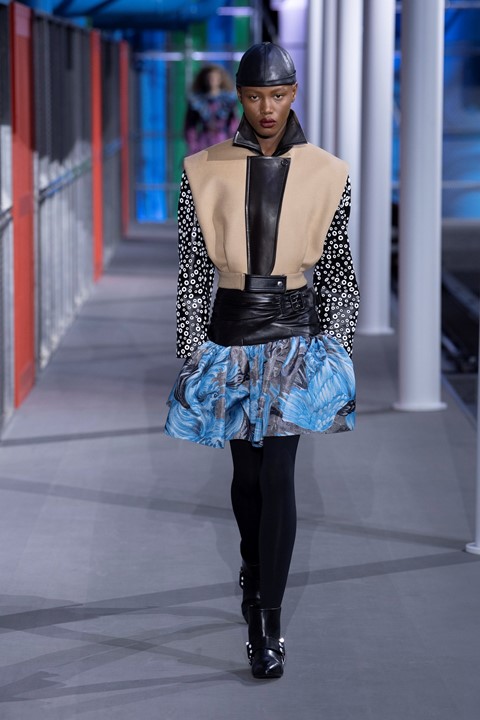
Myriad monograms
Louis Vuitton’s famed monogram has been reimagined by Ghesquière on numerous occasions. Of course, they grace the bags in unexpected shades, spliced into new prints, but it is the way in which they work across the clothes that proves his truly deft hand. In this latest collection, one can spot the house’s checkerboard Damier print, cast onto patchwork leather skull caps and acid-yellow and black pencil skirts. At other times that checkerboard has been printed onto waistcoats (S/S16) in finer grey and black squares that closer resemble the cream and grey Neverfull totes carried by Vuitton’s loyal clientbase – but this time distinctly darker. In that same collection the LV monogram spatters a punkish-striped biker jacket; for Resort 2019 it peeked out of linings of coats too. But even by his second womenswear ready-to-wear collection for the brand, S/S15, the four-leafed quatrefoil of the monogram formed the shape of block-heeled boots – worn with crocheted minidresses they lifted ankle boots in black and red croc, slick knee-highs and the heels themselves came in a punchy Pepto Bismol-pink vinyl. That same quatrefoil has been written into lace (Resort 2016) and wrought in leather that covered bodices and floor-length gowns – barely perceptible to the untrained eye.
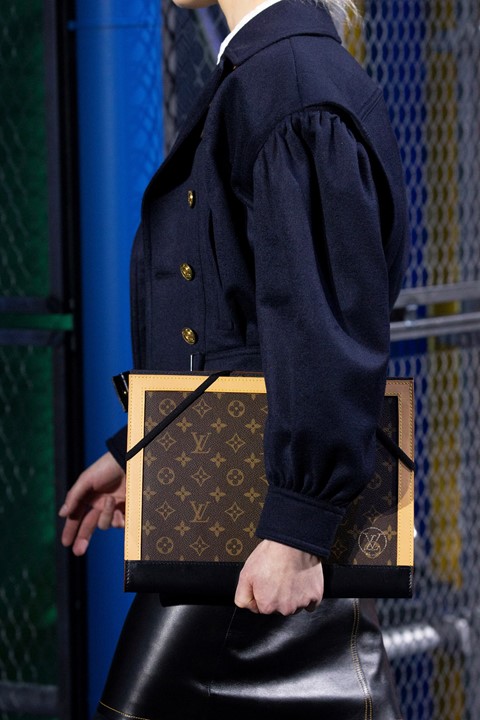
The sci-fi shoulder
“People used to define me as a futurist designer, but, for me, the future is now,” Ghesquière told AnOther Magazine for the S/S19 issue. And while futurism has long characterised Ghesquière’s work – his spacey shell dresses and C3PO leggings at Balenciaga; his spaceship sets, mecha anime inspiration, virtual campaign stars and Tron-like colour work at Vuitton – it is its blend with the past, and a penchant for retrofuturism (an imagined futurist aesthetic devised in the 60s, 70s and 80s) that makes it now. Since Beha Erichsen’s opening look, Ghesquière has explored the shoulder through these parameters – expanded it, refined it, rounded it – in a variety of ways, building a catalogue of crisp, interstellar silhouettes. In that very first collection we saw a 70s lapel swing out from neckline to shoulder (typically in variations of orange/tan on black or vice-versa). This season, ruffled bibs in 80s print clashes drew the eye outwards. Often, the shoulder is accentuated without any work on the shoulder at all – a deep and wide V-neckline, now signature, or a cinched waist, can lend any skater dress or 80s suiting the appearance of a Ghesquière feature shoulder. Each code forming a cornerstone of the erudite language this designer has written for the brand.
